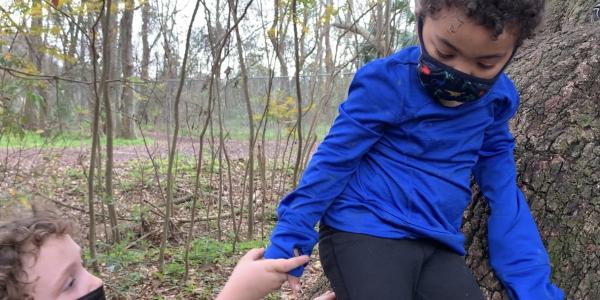Message in a Backpack™ Encouraging Your Child Through Risks During Play

You are here
Outdoor, nature-based play like climbing, balancing, and playing big body games (such as tag) is essential for children’s growth and learning. Yet this kind of “risky play” can bring questions and worries: Should my child climb a tree? Should they go that high? Should they jump or swing from that branch? What if they trip? What if they get stuck? What if they fall?
The concept of risk, however, doesn’t have to be scary. Risk is an important part of developing children’s confidence, resilience, and trust in themselves, others, and the broader world. Here are a few tips to help you encourage and support your children as they take risks!
- Know your child. Every child has a different level of comfort, skill, and interest, so what constitutes a risk-rich experience will vary. While you should never let your child do something that you know they’re not ready for, it’s important to give them room to stretch how they explore and play safely. For example, is your child working on climbing? Let them take a few extra moments to climb down from a structure by themselves rather than lifting them off. Is your child visibly nervous? Take a moment and watch them, providing an opportunity for them to regulate themselves.
- Talk them through it. When a child embraces risk, our first instinct may be to remove them from the situation or warn them to “be careful.” A more meaningful response is to talk them through the risk. This way, we build children’s risk assessment and confidence. Before jumping in, take a moment to observe your child. What are they working on? What are the potential risks they face? Encourage them to think about or remember a goal for their activity (perhaps to reach the top of the play structure or the next branch). Then, invite them to tell you how their brain and their body feel as they work toward it. Siblings, same-aged peers, and friends are also good candidates for talking through risk with children.
- Embrace challenge (and failure!) as a learning opportunity. The way a child responds to risk has to do with framing. If we are afraid or worried for them or if we shield them from risky play, they may miss many chances to learn to manage their emotions, expectations, and the experiences of challenge and failure. Risky situations are opportunities to use encouraging, empowering language. A phrase such as, “Let’s try it out and see what we can learn,” establishes an expectation of effort and your confidence in your child as they prepare to embrace a challenge. Once they’ve finished a task, questions like, “What did you learn? What would you do differently next time?” or “What worked well? How did it make you feel when you . . . ?” celebrate the child’s accomplishment while showing them that there is always room for growth.
When we give children time, space, and support to experience risk and to reflect on it, we give ourselves space to be amazed and proud of all that our children can do.
Ron Grady, MSEd, is an early educator, author, and illustrator whose written and artistic work focuses on children’s social worlds. He is a third-year doctoral student studying education at Harvard.